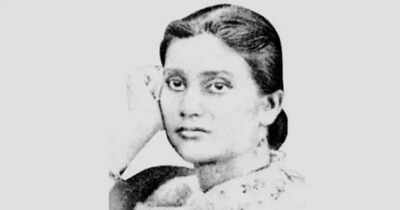ARTICLE AD BOX

Born in a Brahmo family in Chandsi, in Bengal's Barisal district (now in Bangladesh) on July 18, 1861 Kadambini Basu along with Chandramukhi Basu, became the first female graduates in India, from Bethune College in Kolkata. Not only that, she was the first female doctor in South Asia to get three bachelor's degrees in medicine! Let's look back at the greatness of this inflexible woman.
Dating back to a time when women were confined within abodes, expected to remain invisible, unheard, and unquestioning, Kadambini Ganguly’s voice reverberated through the male-dominated corridors of medical college.
The doors of Calcutta Medical College had echoed with a thousand footsteps, but never once those of a woman, until Ganguly knocked, not with hesitation, but with resolve.Yes, it is a story that not only swells our chests with pride, but also upholds a legacy worth cherishing. The same eyes that had once seen shuttered schoolrooms, male-only lecture halls, and a society terrified by the simple sight of a woman carrying books, those very eyes now led a battle India had never before witnessed.
No garlands. No applause. Just a quiet resolve.She did not come to be welcomed. She came to rewrite the rules in ink and scalpels, where women were never meant to leave a mark.
A childhood lit by rebellion
Born on 18 July 1861 in Bhagalpur, Bengal Presidency, now Bihar, Kadambini Basu entered the world as a contradiction. She belonged to the Kulin Kayastha caste, a socially elevated group that paradoxically resisted female education. But her father, Braja Kishore Basu, who had a different lens for society, became the cornerstone of a history in making.
In a world where educating girls was considered blasphemous, he initiated the first women's organization in India, the Bhagalpur Mahila Samiti, when his daughter was just two.In 1878, she shattered a glass ceiling and inscribed her name into the annals of history: Kadambini Ganguly became the first woman to pass the University of Calcutta’s entrance examination. By 1883, alongside Chandramukhi Basu, she graduated from Bethune College, becoming one of the first two female graduates in India.But for Kadambini, education was never the destination; it was only the beginning. Her path did not end with a degree; it pressed forward, with firm determination, toward a profession the world insisted was not meant for women: Medicine.Did success feel like a celebration? Alas, no. It felt like isolation. She had to outthink, outwork, and outlast everyone around her, not because she wanted to prove herself better, but only to prove that she was “equal.”
A doctor against the odds
Her decision to pursue medicine was not only courageous but unthinkable at that time. She was among the few Indian women to seek higher education, and she did so in a world brimming, and reeking, of patriarchy. As she stepped into the medical college, a different battle began altogether. She was ostracised, mocked, and pushed aside for being a female. The professors never knew how to talk to a female student. Females, if present at all, were just bodies to be examined, not the ones doing the examining.She passed her exams in 1888 and was appointed assistant physician at the Lady Dufferin Hospital in Calcutta, a rare post for an Indian woman. Yet even within those walls, her skin and gender placed her beneath her European counterparts. When she was denied senior positions simply because she was Indian, she wrote a public letter to the press. With scalpel in hand, she was peeling off every layer of patriarchy. Frustrated by this institutional discrimination, she set her sights abroad.
A trailblazer in the West
In 1893, she traveled alone to the United Kingdom to advance her medical training. In that particular year, she earned three prestigious qualifcations: the Licentiate of the Royal College of Physicians (LRCP) in Edinburgh, the Licentiate of the Royal College of Surgeons (LRCS) in Glasgow, and the Graduate of the Faculty of Physicians and Surgeons (GFPS) in Dublin.Equipped with accolades, she made her way back to India and established her private practice, specialising in gynecology and women’s health.
Patients from across social strata, including the Nepalese royal family, sought her care. She treated ailments cloaked in silence, subjects Indian society refused to name.
The fight for equality
But Kadambini's commitment to healing was not restricted to medicine alone. She was a fervent reformer, she was active in the Brahmo Samaj, working to abolish child marriage, the dowry system, and the marginalisation of widows. She joined the Bengal Ladies’ Association, championing girls’ education and women's spiritual and intellectual growth.When the British contemplated raising the age of consent for girls from 10 to 12, Kadambini’s counsel was sought. Her voice helped shape the Age of Consent Act of 1891—an early legislative strike against child marriage.She also investigated the brutal conditions faced by women workers in the coal mines of Bihar and Orissa, serving on a committee that documented their suffering. These were not symbolic gestures; her activism had teeth and consequence.
A living legacy
Her legacy is not only glorified in textbooks alone. It dwells in the first girl in a village who dares to challenge patriarchal norms and picks up a biology book. It is in every woman doctor who walks into a hospital and is not called a miracle, but a colleague. It breathes in the hearts of women who carry dreams heavier than the burdens society places on their shoulders. It flickers in the eyes of every girl who chooses courage over silence, and belief over fear.Kadambini Ganguly is not just a name we remember; she is a feeling we carry. A whisper in moments of doubts. A fire in moments of resolve. She did not want to be honoured. She wanted to be echoed.And in every girl who dares, she is.



.png)
.png)
.png)
















 8 hours ago
6
8 hours ago
6







 English (US) ·
English (US) ·